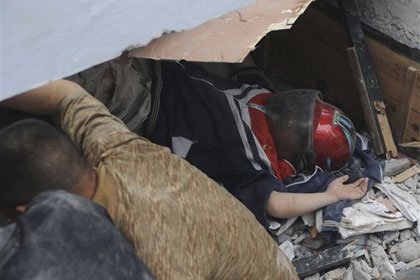A powerful earthquake toppled buildings, schools and a chemical
plant Monday in central China, killing more than 8,700 people and
trapping untold numbers in mounds of concrete, steel and earth in
the worst quake in three decades.
A powerful earthquake toppled buildings, schools and a chemical plant Monday in central China, killing more than 8,700 people and trapping untold numbers in mounds of concrete, steel and earth in the worst quake in three decades.
The 7.9-magnitude quake devastated a region of small cities and towns set amid steep hills north of Sichuan’s provincial capital of Chengdu. Striking in midafternoon, it emptied office buildings across the country in Beijing and could be felt as far away as Vietnam.
Snippets from state media and photos posted on the Internet underscored the immense scale of the devastation. In the town of Juyuan, south of the epicenter, a three-story high school collapsed, burying as many as 900 students and killing at least 50, Xinhua said. Photos showed people using cranes, mechanical hoists and their hands to remove slabs of concrete and steel.
The earthquake hit one of the last homes of the giant panda at the Wolong Nature Reserve and panda breeding center, in Wenchuan county, which remained out of contact, Xinhua said.
In Chengdu, it crashed telephone networks and hours later left parts of the city of 10 million in darkness.
“We can’t get to sleep. We’re afraid of the earthquake. We’re afraid of all the shaking,” said 52-year-old factory worker Huang Ju, who took her ailing, elderly mother out of the Jinjiang District People’s Hospital. Outside, Huang sat in a wheelchair wrapped in blankets while her mother, who was ill, slept in a hospital bed next to her.
Xinhua reported 8,533 people died in Sichuan alone and 216 others in three other provinces and the mega-city of Chongqing.
Worst affected were four counties including the quake’s epicenter in Wenchuan, 60 miles northwest of Chengdu. Landslides left roads impassable Tuesday, causing the government to order soldiers into the area on foot, state television said, and heavy rain prevented four military helicopters from landing.
Wenchuan’s Communist Party secretary appealed for air drops of tents, food and medicine. “We also need medical workers to save the injured people here,” Xinhua quoted Wang Bin as telling other officials who reached him by phone.
To the east, in Beichuan county, 80 percent of the buildings fell, and 10,000 people were injured, aside from 3,000 to 5,000 dead, Xinhua said. State media said two chemical plants in an industrial zone of the city of Shifang collapsed, burying hundreds of people and spilling more than 80 tons of toxic liquid ammonia.
Premier Wen Jiabao, a geologist by training, called the quake “a major geological disaster,” and traveled to the disaster area to oversee rescue and relief operations.
“Hang on a bit longer. The troops are rescuing you,” Wen shouted to people buried in the Traditional Medicine Hospital in the city of Dujiangyan, on the road to Wenchuan, in comments broadcast by CCTV.
“As long as there was a slightest hope, we should make our effort a hundred times and we will never relax,” he said outside the collapsed school in Juyuan.
The quake was the deadliest since one in 1976 in the city of Tangshan near Beijing that killed 240,000 – although some reports say as many as 655,000 perished – the most devastating in modern history.
Monday’s quake occurred on a fault where South Asia pushes against the Eurasian land mass, smashing the Sichuan plain into mountains leading to the Tibetan highlands – near communities that held sometimes violent protests of Chinese rule in mid-March.
Much of the area has been closed to foreign media and travelers since then, compounding the difficulties of getting information. Roads north from Chengdu to the disaster area were sealed off early Tuesday to all but emergency convoys.
While most buildings in the city held up, those in the countryside tumbled. On the outskirts of Chongqing, a school collapsed, killing at least five people. Residents said teachers kept the children inside, thinking it was safer.
The earthquake also rattled buildings in Beijing, 930 miles to the north, causing evacuations of office towers. People ran screaming into the streets in other cities, where many residents said they had never felt an earthquake.
In Beijing, where hundreds of thousands of foreign visitors are expected for the Olympics, stadiums, arenas and other venues for the games were undamaged.
Li Jiulin, a top engineer on the 91,000-seat National Stadium – known as the Bird’s Nest and the jewel of the Olympics – was conducting a site inspection when the quake struck. He told reporters the building was designed to withstand a 8.0 quake.















